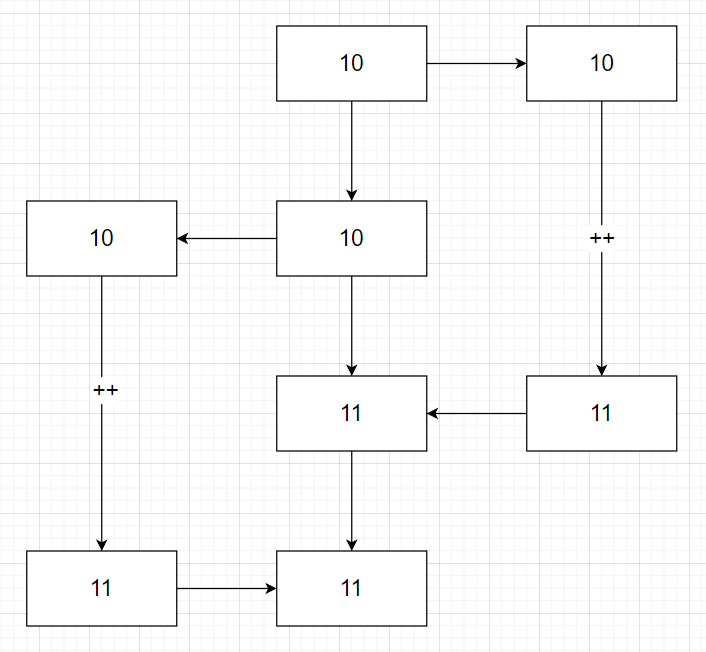🗳 教我唱票
题目
XuKaFy 刚刚开始学习并发。他用 C 写了一个模拟唱票程序:
// count.c
#include <stdio.h>
#include <stdlib.h>
#include <pthread.h>
volatile int counter = 0;
volatile int bucket[32768] = {0};
typedef struct {
int count;
int* start;
} Task;
void* fun(void* arg) {
Task* task = (Task*) arg;
for (int i = 0; i < task->count; ++i) {
++counter;
++bucket[task->start[i]];
}
return NULL;
}
int main(int argv, char* argc[]) {
if(argv != 2) {
printf("Usage: count <value>\n");
return 0;
}
int n = atoi(argc[1]);
if(n <= 0) {
printf("Invalid value\n");
return 0;
}
printf("n = %d\n", n);
int* ticket = (int*) malloc(sizeof(int) * n);
for (int i = 0; i < n; ++i) {
ticket[i] = rand() % 32768;
}
Task t1 = {n / 2, ticket};
Task t2 = {n / 2 + (n % 2), ticket + n / 2};
pthread_t p1, p2;
pthread_create(&p1, NULL, fun, (void*) &t1);
pthread_create(&p2, NULL, fun, (void*) &t2);
pthread_join(p1, NULL);
pthread_join(p2, NULL);
printf("Counter = %d\n", counter);
int count = 0;
for (int i = 0; i < 32768; ++i) {
count += bucket[i];
}
printf("Count = %d\n", count);
free(ticket);
return 0;
}
其中,n 是真实票数,Counter 为两个线程加起来的唱票数,Count 为桶计数以后的票数。
当然,当 n 比较小的时候,XuKaFy 的唱票程序没有什么问题,直到某一天:
prompt> ./count 200000
n = 200000
Counter = 108201
Count = 199996
XuKaFy 极其不解,他又运行了几遍,发现似乎有这样一个规律:
后来,XuKaFy 知道 valgrind 可以检查内存泄漏,然后就试了一下:
prompt> valgrind --leak-check=yes ./count 1000000
==837== Memcheck, a memory error detector
==837== Copyright (C) 2002-2017, and GNU GPL'd, by Julian Seward et al.
==837== Using Valgrind-3.15.0 and LibVEX; rerun with -h for copyright info
==837== Command: ./count 1000000
==837==
n = 1000000
Counter = 1000000
Count = 1000000
==837==
==837== HEAP SUMMARY:
==837== in use at exit: 0 bytes in 0 blocks
==837== total heap usage: 4 allocs, 4 frees, 4,001,568 bytes allocated
==837==
==837== All heap blocks were freed -- no leaks are possible
==837==
==837== For lists of detected and suppressed errors, rerun with: -s
==837== ERROR SUMMARY: 0 errors from 0 contexts (suppressed: 0 from 0)
虽然没有内存泄露,但是:
请你解释解释为什么,并且帮 XuKaFy 改改代码。
题解
解释
自增时,变量先被从内存中复制到寄存器里,然后完成自增操作,再重新写回内存。当多个线程对同一个变量进行自增的时候,会出现下面这种情形:(图中左侧右侧为两个线程的寄存器,中间为共同操作的变量)

结果是:两次自增,变量却只加了一。自增得越频繁,这样的情况就会发生的越多。
对于 counter 来说,所有的票都会使它自增。但是对于 bucket 的每一个元��素而言,只有部分的票会使它自增。后者自增没有前者那么频繁,所以最后 counter 发生上面情形的机会远高于所有 bucket 的元素之和。
由此可得:
修改
使用了 C11 的 _Atomic。
// modified count.c
#include <stdio.h>
#include <stdlib.h>
#include <pthread.h>
_Atomic int counter = 0;
_Atomic int bucket[32768] = {0};
typedef struct {
int count;
int* start;
} Task;
void* fun(void* arg) {
Task* task = (Task*) arg;
for (int i = 0; i < task->count; ++i) {
++counter;
++bucket[task->start[i]];
}
return NULL;
}
int main(int argv, char* argc[]) {
if(argv != 2) {
printf("Usage: count <value>\n");
return 0;
}
int n = atoi(argc[1]);
if(n <= 0) {
printf("Invalid value\n");
return 0;
}
printf("n = %d\n", n);
int* ticket = (int*) malloc(sizeof(int) * n);
for (int i = 0; i < n; ++i) {
ticket[i] = rand() % 32768;
}
Task t1 = {n / 2, ticket};
Task t2 = {n / 2 + (n % 2), ticket + n / 2};
pthread_t p1, p2;
pthread_create(&p1, NULL, fun, (void*) &t1);
pthread_create(&p2, NULL, fun, (void*) &t2);
pthread_join(p1, NULL);
pthread_join(p2, NULL);
printf("Counter = %d\n", counter);
int count = 0;
for (int i = 0; i < 32768; ++i) {
count += bucket[i];
}
printf("Count = %d\n", count);
free(ticket);
return 0;
}
valgrind
valgrind 的检查有效内存的原理是给可用地址打表。为了支持多线程,这个表是上了锁的。当访问某个地址的时候,valgrind 会去查这个表,表就被锁了,于是其他想要访问这个地址线程只能先等着。所以最后所有自增都有序进行,没有发生前面遇到的情况。